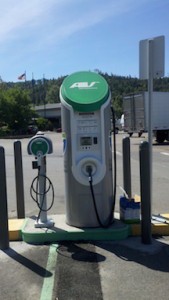Setting Up Your Main Place To Plug In
The future is here! And it’s confusing as Hades. Electric vehicles have never been more popular – or more discombobulating. What’s the average driver to do with MPGe, kWh, UPC and other bits of alphabet soup?
Fear no more. These three simple steps combobulate the issue and answer the question, “How do I prepare for owning an electric car?â€
1. Install a home charging station.
Plugging in an electric car is not as straightforward as plugging in a coffee maker. A lithium-ion battery draws an immense amount of power, and the typical 120-volt 8-amp shared circuit simply will not do. Plugging in a Nissan Leaf into a bedroom outlet would take 25 hours for a full charge!

This is more than inconvenient. It is bad business. Really saving money with an electric car requires charging the vehicle during off-peak night hours when lower rates are often offered by utilities. Full-day recharging periods, therefore, can double charging costs in urban areas.
An electric vehicle requires a minimum 120-volt, 12- or 15-amp dedicated circuit. No other appliance should steal the juice. The vehicle—and only that vehicle—should draw current from that circuit. But even then, replenishing the typical electric car could still steal away 12-18 hours.
Enter the Level 2 240-volt charger. Level 2 chargers usually run at 20-40 amps and slice charging times in half. Any driver who commutes daily in an electric car should hire a qualified electrician to install a Level 2 charger.
Some Level 2 chargers can be had straight from the manufacturer. Nissan and AeroVironment, for instance, partnered to provide a $2,000 charging dock and installation package to Leaf owners.

Most others are priced between $1,200 and $2,500. The ones with ritzy perks – charge timers, smartphone connectivity, LED displays – cost more.
Also, consider investing in high-quality surge protection. Even though the cost of batteries is rapidly dropping, the average BEV battery takes out a big bite: $12,000-$20,000. That’s an expensive lightning bolt strike. Whole-house surge protection, on the other hand, costs less than $1,000. Do-it-yourself electricians can also route currents through a heavy-duty UPS. Municipal permits may be necessary.
Oh, and get a foam fire extinguisher. The aqueous electrolyte of lithium batteries is highly flammable and is not easily snuffed out with water. Chances of ignition are one in a million, but who wants to end life as a news headline?
2. Install climate conditioning
Batteries, like kids, prefer their juice at a certain temperature. The typical lithium-ion battery can be charged between 32 and 112 degrees Fahrenheit, and they prefer 50 to 86 degrees F. Yet during summer, a Missouri garage might boil to 120 degrees Fahrenheit, and during winter, a Michigan garage might glaciate at -30 degrees F. Severe temperature conditions or fluctuations can severely diminish charge capacity and battery life. So treat a battery like it’s a pet, and keep it cozy.
3. Drive strong.
Last but not least, download the PlugShare iPhone or Android smartphone app, which lists locations and directions for more than 10,000 public (and some private) charging stations around America.
For more garage ideas, please visit Modernize.com.

21 thoughts on “3 Steps to Getting Your Garage Ready for an Electric Car”